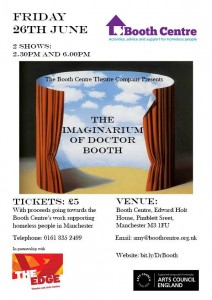The Imaginarium of Doctor Booth
Post by Naomi Paxton
The Imaginarium of Doctor Booth was a piece written by Janine Waters, the artistic director of The Edge Theatre and Arts Centre in Chorlton, Manchester. Waters has been running weekly drama sessions at the Booth Centre, a day centre for homeless people, for many years – firstly as part of a joint initiative with the Royal Exchange Theatre and currently as part of a collaborative partnership between the Booth Centre and The Edge. Simon Waters, the Musical Director at The Edge, runs weekly music workshops there too and composed the songs for the performance.
Developed over many weeks and presented in traverse, The Imaginarium of Doctor Booth involved movement, acting and singing and had a cast of 14, made up of service users, volunteers and support workers at the Booth Centre and one professional actress. Simon accompanied the singing on a keyboard situated outside of the playing space and there was a simple lighting rig which allowed for subtle changes of stage where necessary. Two performances were given at the Booth Centre on Friday 26th June (see poster above) and one a week later at The Edge.
The piece played with ideas of representation, notions of need, economic deprivation, happiness, friendship and music. Two songs written especially for the Booth Centre group were featured, there was the recitation of a Shakespearean sonnet and a self-penned poem, quotations from sources as diverse as Lily Tomlin, Aesop and Plato and an exploration of the perception and exploitation of the ‘deserving’ poor by the media.
After a morning of rehearsal, the nervous energy in the group before the first show was palpable. There was a low fizz of anticipation and a heightened awareness to and amongst members of the group. For the Booth Centre performances there was no separate ‘off-stage’ space, so the cast waited behind a screen to come into the main playing area. This meant that the audience were both visible and audible, adding to the tension. At the Edge, this was not the case and the pre-show jitters were expressed much more physically – the women in the cast, myself included, standing still and silent near the entrance door whilst the men in the cast paced around the dressing room area. In the gap between the final rehearsal and the performance, the nervous energy of the group bubbled into physical action, with lessons in tap dancing and the sharing of anecdotes.
It was noticeable that frictions between individuals that had sometimes arisen during the rehearsal process became irrelevant in performance. Errors made during the performance were accommodated instinctively by the whole ensemble over all three shows. Group members from the Booth Centre drama sessions who had been unable to be part of the final performances had their contributions to the rehearsal and development process included in the final script – e.g. “Joan said that.”
There were few one on one interactions in the piece – mostly the performers were speaking and singing out to the audience, not to each other. I wondered how much of this was strategic, how much about the realities of vulnerable interpersonal relationships or potential disruptive conflict and how much about the practicalities of rehearsing a large group with no guarantee of attendance. The audiences, although small in numbers, were very appreciative and generous in their reactions. At both venues, Booth Centre support workers and volunteers were represented in the audience, which I took to be a hugely supportive gesture. However, in the group discussion held after the first performance, one group member expressed his disappointment that so few audience members from outside the Booth Centre had attended, feeling that this somehow invalidated the success of the show and his efforts during it. Despite reassurances, he was still sore on this point a week later, before the third performance of the piece at The Edge. When asked why he seemed unable to articulate his disappointment in more detail, but admitted that he hadn’t invited anyone to the shows himself.
I think that the accommodating and innately understanding nature of the audience, fully aware of the background of many of the performers, made the performances possible. The collective energy and camaraderie of the group was both touching and exciting – they rose to the occasion every time, carefully negotiating personal relationships and clearly keen to perform to the best of their ability. In all, The Imaginarium of Doctor Booth seemed to be a success – giving confidence to the performers and showing the audience how versatile the group can be.
To see interviews with some of the Booth Centre Theatre Company who took part in the performance, visit the Poor Theatres site, or our YouTube channel.


Comments are closed
Sorry, but you cannot leave a comment for this post.